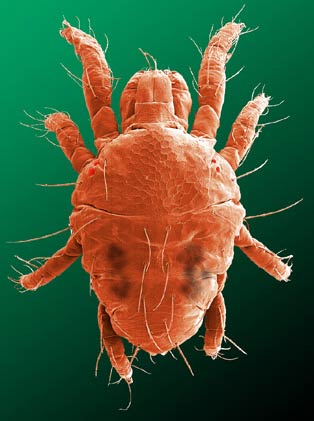| Home | Exotic Mite Pest Families Home | Glossary | Open Tetranychinae subkey |
Tetranychoidea: Tetranychidae, Tetranychinae
Superorder Acariformes
Order Trombidiformes
Suborder Prostigmata
Supercohort Eleutherengonides
Cohort Raphignathina
Superfamily Tetranychoidea
Family Tetranychidae
Subfamily Tetranychinae
Common names: spider mites, red mites, two-spotted mites, six-spotted mites
Probability of Encounter: Very high
Quarantine importance:
Very high. The Tetranychidae contains a number of devastating pests of
plants and most of the species of high importance on the Priority Pest List.

Diagnosis:
Empodium without tenent hairs, usually claw-like, bifurcate, with or without proximoventral hairs; sometimes highly reduced and appearing absent.
Prodorsum with 4 pairs of setae (vi, ve, sci, sce)
Adult female with 1-2 pairs of anal setae (males with 4 pairs of ano-genital setae).
Cheliceral bases adnate, fused mesally into a stylophore (sometimes withdrawn into the body); chelicerae with fixed digit reduced and movable digit whiplike.
Peritremes typically chambered structures on the dorso-lateral surface of the prodorsum; naso absent; prodorsal trichobothria absent; 2 pairs of eye lenses usually present. Palps 5 segmented; with thumbclaw process (claw-like seta on the palp tibia and a thumb- or button-like subterminal palp tarsus). Leg tarsi usually with tenent hairs on claws or empodium. Genital papillae absent; males with an intromittent aedeagus.
Similar taxa. The Stigmaeidae are sometimes confused with spider mites, but these predatory mites lack the whip-like movable digits. Cryptognathidae are capable of retracting their gnathosoma, but their cheliceral bases are free and the movable digit is hook-like. Bryobiinae have empodia with tenent hairs.
Ecology & Distribution. The Tetranychinae includes the infamous two-spotted and other major economic spider mite pests. Many are capable of spinning dense webs; others use silk only to attach their eggs to leaves and stems.
References
Baker EW & Pritchard AE. 1960. The tetranychoid mites of Africa. Hilgardia 29(11): 455-574.
Baker EW & Tuttle DM. 1994. A guide to the spider mites (Tetranychidae) of the United States. Indira Pub. House, West Bloomfield, MI: 347 pp.
Beard JJ, Walter DE, Allsopp P. 2003. Spider Mites of Sugarcane in Australia: A Review of Grass-feeding Oligonychus Berlese (Acari: Prostigmata: Tetranychidae) with the description of four new species. Australian Journal of Entomology 42: 51-78.
Bolland, H.R., J. Gutierrez & C.H.W. Flechtmann. 1998. World Catalogue of the Spider Mite Family (Acari: Tetranychidae). Brill: Leiden.
Evans, G.A., H.L. Cromroy & R. Ochoa. 1993. The Tenuipalpidae of Honduras (Tenuipalpidae: Acari). Florida Entomologist 76: 126–155.
Helle W. & M.W. Sabelis (eds.) 1985. Spider Mites, Their Biology, Natural Enemies, and Control, vol. 1A. Elsevier: New York.
Hislop, R.G. & L.R. Jeppson. 1976. Morphology of the mouthparts of several species of phytophagous mites. Annals of the Entomological Society of America 69: 1125–1135
Jeppson L.R., H.H. Keifer & E.W.Baker 1975. Mites Injurious to Economic Plants, University of California Press: Berkeley
Krantz GW. 1978. A Manual of Acarology. OSU Bookstores: Corvallis.
Meyer, M.K.P.S. 1979. The Tenuipalpidae (Acari) of Africa with keys to the world fauna. Entomology Memoir Department of Agriculture Technical Services Republic of South Africa 50: 1–135.
Meyer, M.K.P.S. & E.A. Ueckermann 1997. A review of some species of the families Allochaetophoridae, Linotetranidae and Tuckerellidae (Acari: Tetranychoidea). International Journal of Acarology 23: 67–92.
Mignon A & CHW Flechtmann 2004. First additions and corrections to the World Catalogue of the Spider Mite Family (Acari: Tetranychidae). Intern. J. Acarol. 30: 143-152.
Ochoa, R., H. Aguilar & C. Vargas 1994. Phytophagous Mites of Central America: An Illustrated Guide CATIE, Turrialba, Costa Rica.
Tseng Y-H 1990. A monograph of the mite family Tetranychidae (Acarina: Trombidiformes) from Taiwan. Taiwan Museum Special Publication series 9. 224 pp.
Zhang Z-Q. 2003. Mites of greenhouses: identification, biology and control. CABI Publishing, Wallingford: 244 pp.